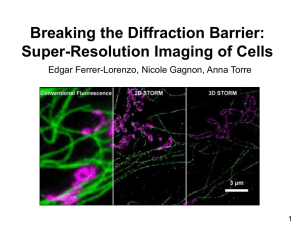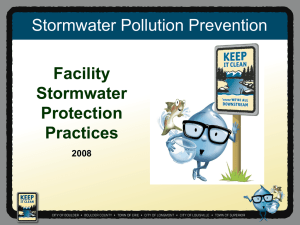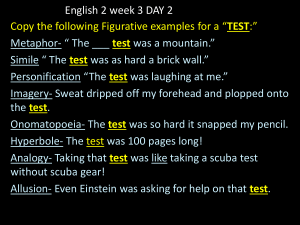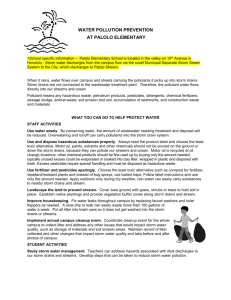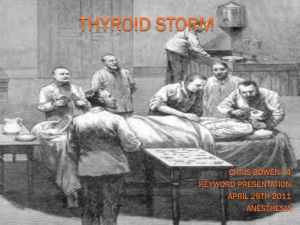Municipal Facilities SWP3 Template
advertisement
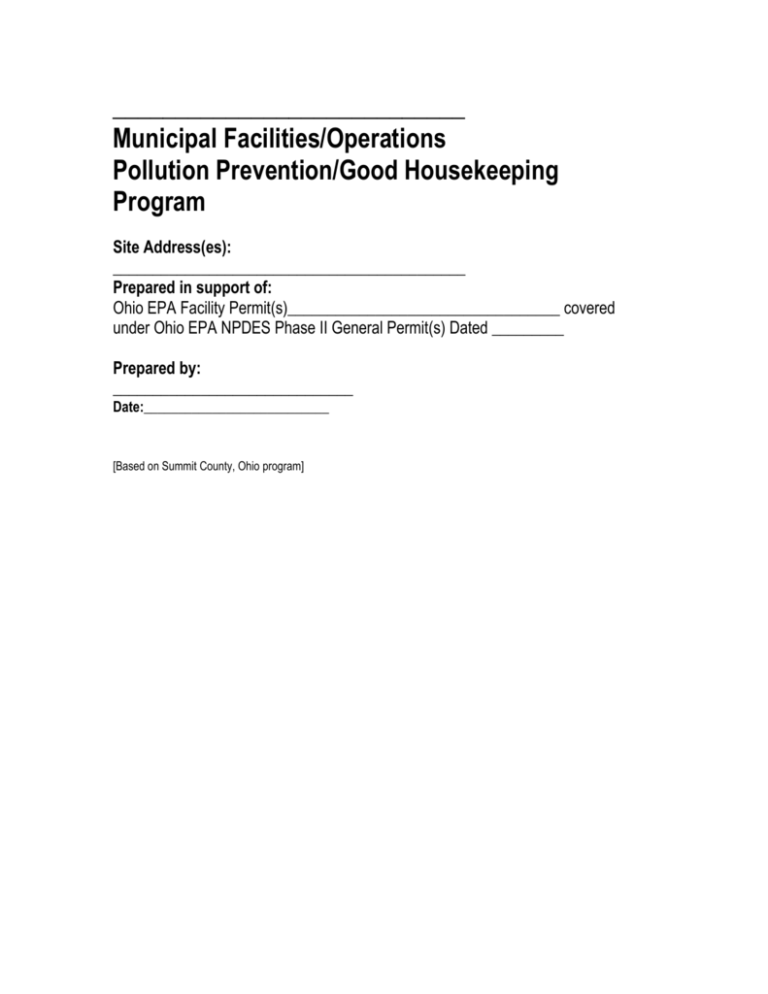
____________________________ Municipal Facilities/Operations Pollution Prevention/Good Housekeeping Program Site Address(es): ____________________________________________ Prepared in support of: Ohio EPA Facility Permit(s)__________________________________ covered under Ohio EPA NPDES Phase II General Permit(s) Dated _________ Prepared by: ______________________________ Date:___________________________ [Based on Summit County, Ohio program] Municipal Facilities/Operations Pollution Prevention/Good Housekeeping Program Table of Contents Section Description ................................................................................................................ Page 1.0 Introduction ................................................................................................................................ 1 2.0 Description of Municipal Facility and Operations ........................................................................ 2 2.1 Site Map/Layout of Municipal Facility or Operation ..................................................................... 3 3.0 Description of Proposed BMPs .................................................................................................. 5 3.1 Pollution Prevention Training for Employees.............................................................................. 5 3.2 Eliminating Illicit and Non-Storm Water Discharges ................................................................... 5 3.3 Spill Prevention, Control, and Cleanup ....................................................................................... 6 3.4 Outdoor Equipment Operations .................................................................................................. 7 3.5 Outdoor Materials Storage and Handling ................................................................................... 8 3.6 Waste Handling and Disposal .................................................................................................... 9 3.7 Vehicle and Equipment Washing ............................................................................................... 9 3.8 Materials Receiving Areas ........................................................................................................ 10 3.9 Vehicle and Equipment Maintenance and Storage Areas ........................................................ 10 3.10 Vehicle and Equipment Fueling Areas ................................................................................... 11 3.11 Facility Good Housekeeping Activities ................................................................................... 12 3.12 Facility and Municipal Construction Activities ......................................................................... 12 3.13 Storm Water Management: Water Quality Controls ............................................................... 13 4.0 Reporting and Record Keeping Requirements ......................................................................... 14 4.1 Annual Site Inspection ............................................................................................................. 14 4.2 Non-Storm Water Discharge Visual Inspection ........................................................................ 14 4.3 Storm Water Discharge Visual Inspection ................................................................................ 14 List of Tables 1.0 Acceptable Non-Storm Water Discharges ................................................................................. 18 Appendices Appendix A: Site Inspection Forms .................................................................................................... i Facility/Operations Storm Water Inspection Checklist Spill/Release Incident Reporting Form Non-Storm Water Discharge Visual Inspection Form Storm Water Discharge Visual Inspection Form Annual Site Inspection Form Municipal Facilities/Operations Pollution Prevention/Good Housekeeping Program 1.0 Introduction This Municipal Facilities/Operations Pollution Prevention/Good Housekeeping Program (PPGHP) for the [insert site name and location here] ___________________________ site(s) has been prepared as part of the [insert community name here] __________________ Storm Water Management Program (SWMP). The SWMP was submitted in fulfillment of the requirements of the Ohio Environmental Protection Agency (Ohio EPA) National Pollutant Discharge Elimination System (NPDES) Phase II General Permit (Ohio EPA Permit). The SWMP was approved for coverage under the Ohio EPA Permit under the following Facility Permit Number: [usually begins with 3GQ or 2GQ] ___________________. The program described in this document has been developed by [insert community name] _________________ with the intent to reduce the discharge of pollutants from municipal operations at the [insert site name and location here] _____________________________ site. It is the intent of this program to reduce the discharge of pollutants from the site to the maximum extent practicable, to protect water quality, and to satisfy the appropriate water quality requirements of Ohio Revised Code 6111 as described in the Ohio EPA Permits. Specifically, this document addresses pollution prevention and good housekeeping for municipal operations as described in Control Measure 6 of the Ohio EPA Permits. [insert community name here] _______________________ has committed to implement pollution prevention and good housekeeping Best Management Practices (BMPs) to reduce or prevent the discharge of pollutants in storm water runoff from municipal operations and facilities within their municipal separate storm sewer system (MS4). This PPGHP is the main focus of the program’s BMPs for Control Measure 6 in the SWMP. This document has been prepared following observations and inspections of the site and municipal operations. During the inspections, the existing storm water control measures already in place were documented, and existing and potential impacts to storm water runoff were noted. Components of other plans already in place at the facilities (such as spill response and prevention plans) were incorporated into this PPGHP or expanded upon as necessary. This PPGHP presents storm water controls that will then be used by the [indicate department(s) here] __________________ to perform regular employee training and to implement and evaluate BMPs and controls at the facility to fulfill the requirements of the Ohio EPA permits. The following section of the document describes the municipal site or operations that are the focus of the storm water BMPs. The remaining sections of the document contain a description of the BMPs that are recommended to control storm water pollution from specific municipal activities at the site. Each section contains BMPs tailored to control storm water impacts for each particular type of municipal activity or operation. The recommended BMPs will be implemented on an ongoing basis for the indefinite future. [indicate department(s) here] _______________ plans to implement these BMPS or similar controls, wherever they would be effective at preventing pollutants from discharging with storm water from the site. 1 Municipal Facilities/Operations Pollution Prevention/Good Housekeeping Program 2.0 Description of Municipal Facility and Operations Site Address: Primary Site Contact: Title: Phone number: Secondary Site Contact: Title: Phone number: Description of Site Activities: 2 Municipal Facilities/Operations Pollution Prevention/Good Housekeeping Program 2.1 Site Map/Layout of Municipal Facility or Operation If you do not have a set of plans or blueprints of your site and the associated storm drainage system, prepare a rough sketch or site map that shows: □ Onsite watersheds or the direction of storm water drainage across the site and points where storm water enters and leaves your site □ Onsite and adjacent offsite storm water/drainage conveyance systems (pipes, swales, culverts, trench drains, storm drain, catch basins, pipes, ditches, ponds vaults, etc.) □ Buildings □ Areas where each facility operation or material storage takes place (e.g., storage structures and storage areas) □ Location and type BMPs onsite 3 Municipal Facilities/Operations Pollution Prevention/Good Housekeeping Program Figure 1: Sample sketch Figure 2: Site Aerial 4 Municipal Facilities/Operations Pollution Prevention/Good Housekeeping Program 3.0 Description of Proposed BMPs 3.1 Pollution Prevention Training for Employees Successful storm water pollution control relies in large part on proper training and education of employees. Many of the recommended BMPS in this PPGHP will require specific training for employees who conduct the activities. It is essential that employees understand and implement the BMPs that apply to operations within each facility. Training can be completed separately or done in conjunction with regular employee training procedures. Employee training will emphasize the importance of keeping pollutants out of the storm drains, because the drains go directly to the surface waters of the state without benefit of wastewater treatment that the sanitary sewers receive. Facility personnel will be educated about the harmful environmental effects of improper disposal of materials into the storm drain so that they understand the importance of preventing storm water pollution. The following training will be implemented by the [indicate department(s) here] ____________________________________________________________________ : □ Experienced workers or other trained personnel will be used to train facility employees. □ Training will be completed and documented once per year for all appropriate personnel. □ New personnel will be required to review and understand this document prior to initiating work activities. □ __________________________________________________________________ □ __________________________________________________________________ □ __________________________________________________________________ 3.2 Eliminating Illicit and Non-Storm Water Discharges The Ohio EPA Permits prohibit discharges of anything but storm water to the storm drains. [Indicate department(s) here] ________________________ personnel will inspect the facility to be sure no unauthorized discharges enter storm drains or discharge offsite. Connections that allow sanitary or any sort of wastewater to enter the storm drain are prohibited, including storm drain connections from indoor drains or sinks. These are known as illicit connections and must be eliminated. Another form of prohibited discharge is illegal dumping. Pollutants may be introduced to storm drains inadvertently, by routine practices that discharge water outdoors, or they may be released intentionally by routinely discharging wastes, wash water, and other materials to storm drains, catch basins, and other conveyance facilities either on the facility or in the street. A large part of this improper discharge results from employees lack of understanding, coupled with a lack of readily available proper routes for the discharge. Continuing employee training will be needed as described in Section 3.1. [Indicate department(s) here] ______________________ will make a long-term ongoing effort to assure that no illegal discharges will occur from municipal operations at the facility. This requires continuing observations to identify potential sources of intentional or inadvertent illicit discharges. Efforts will be made to discontinue or re-route the storm water from those activities. The following measures to help prevent non-storm water discharges will be implemented: 5 Municipal Facilities/Operations Pollution Prevention/Good Housekeeping Program □ Provide well marked proper disposal or collection methods for solid or liquid waste. □ Train employees in proper disposal of non-storm water discharges. Employees will be educated to understand that storm drains connect directly to streams and other water bodies without treatment. □ Label all storm drain inlets and catch basins “No dumping—flows to streams” so employees can tell which inlets are part of the storm drain system. □ Periodically inspect and maintain the facility operations and BMPS to evaluate the success of efforts to reduce and eliminate non-storm water discharges. □ Periodically inspect and maintain storm drain inlets. Clean out catch basins so that accumulated pollutants do not wash down the storm drains. □ __________________________________________________________________ □ __________________________________________________________________ □ __________________________________________________________________ 3.3 Spill Prevention, Control, and Cleanup Even small spills can have cumulative effects that add up to a significant source of potential pollutants in storm water discharges from the site. The goal is to prevent spills and leaks, maintain a regular inspection and repair schedule, and correct potential spill situations before a spill can occur. When a spill does occur, quick and effective response will prevent pollutants from reaching storm water. Spills will be cleaned up promptly and not allowed to evaporate so that pollutants do not remain on the pavement to be washed to the storm drains with the next rain or remain in the soil to become a possible groundwater pollutant. If the spill is on an unpaved surface, [insert department here] _____________________ personnel will determine whether the contaminated soil should be removed to prevent it from being a source of future storm water pollutants. Spill procedures will also include cleaning up leaks, drips, and other spills without water whenever possible. Spill prevention and response procedures for hazardous materials stored or handled onsite will follow the procedures described in the facility Hazardous Materials Management Plan. [insert department here] __________________ personnel will contain and collect the spilled substance, then dispose of the substances and any contaminated soil in compliance with local hazardous materials regulations. The spill control and cleanup procedures for this facility are as follows: □ Small spills: These are spills that can be wiped up with a shop rag. Wet rags will not be put in the dumpster with the shop trash – they will be stored in a covered bin like the kind used at auto service stations. Used rags will be sent to a professional cleaning service or disposed of with the hazardous wastes if necessary. __________________________________________________________________ __________________________________________________________________ __________________________________________________________________ □ Medium-sized spills: These are spills too large to wipe up with a rag. Medium sized spills will be contained and soaked up using dry absorbent material such as: Vermiculite, 6 Municipal Facilities/Operations Pollution Prevention/Good Housekeeping Program specially-prepared sawdust, or kitty 1itter. Absorbent snakes may be used as temporary booms to contain and soak up the liquid. Used absorbent material will be swept up or collected and will be disposed of with the shop trash if non-hazardous or with the hazardous wastes if necessary. A wet/dry shop vacuum cleaner may also be used to collect spills and dispose of the liquid with hazardous wastes. Vacuums will not be used for gasoline, solvents, or other volatile fluids, because the enclosed vacuum may become an explosive hazard. __________________________________________________________________ __________________________________________________________________ __________________________________________________________________ __________________________________________________________________ . □ Large spills: Spills of non-hazardous liquids will be contained and cleaned using a minimum amount of wash water. Storm drain inlets or sewer inlets will be plugged to prevent the spill enter from entering the MS4. Temporary plugs will be kept onsite for the facility inlets and employees will be trained in when and how to use them. For hazardous materials spills, the procedures described in the Hazardous Materials Management Plan will be implemented. _________________________________________________ __________________________________________________________________ __________________________________________________________________ __________________________________________________________________ A Spill/Release Incident Reporting form is provided in Appendix A. This form should be filled out promptly after a spill or release. 3.4 Outdoor Equipment Operations The facility manager or _________________________ will identify all equipment at the facility that may be exposed to storm water, or that may discharge potential pollutants that may be exposed to storm water. An employee will be assigned to inspect each piece of equipment on a regular basis to see that it is functioning properly. Leaks, malfunctions, staining on and around the equipment, and other evidence of leaks and discharges will be observed and noted. The inspecting person will be responsible for reporting any spills or leaks using the form provided in Appendix A. Spill and leak control and cleanup activities are described in Section 3.3. The equipment operations BMPs for this facility are as follows: □ Equipment will be placed on an impermeable surface, or a drip pan will be installed beneath the potential leak points of the equipment. □ The amount of rainwater that contacts the equipment will be minimized wherever possible. □ __________________________________________________________________ __________________________________________________________________ __________________________________________________________________ 7 Municipal Facilities/Operations Pollution Prevention/Good Housekeeping Program 3.5 Outdoor Materials Storage and Handling Outdoor material storage areas will be inspected for possible exposure of pollutants to storm water runoff. Bulk solid materials, raw materials, and construction materials, or supplies stored outdoors will be covered and protected from storm water if pollutants could enter storm water. Materials of concern on the facility include gravel, sand, lumber, topsoil, compost, concrete, metal products, and others. The BMPs for the outdoor materials storage and handling areas for this facility are as follows: □ Material is stored in one of three ways: On a paved surface with a roof or covering so that no direct rainfall contacts them, and with appropriate berms or runoff controls to prevent run-on of storm water. On a specially constructed paved area with a drainage system with a slope to minimize water pooling. Prevent runoff and run-on with berms or curbing along the perimeter. Drainage is directed to treatment facilities or water quality catch basins along the lower edge of the pad. Covered with plastic sheeting, secured with weights such as fires or sand bags. If possible, a mounded or bermed area that will prevent run-on of storm water through the material will be used. □ The parking lot or other surfaces near bulk materials storage facilities will be swept periodically to remove fines that may wash out of the materials. □ Liquid tanks will be kept in a designated area on a paved impermeable surface and within a berm or other secondary containment. □ Hazardous materials will be stored as described in the Hazardous Materials □ Management Plan and in a manner that ensures storm water protection. □ Outdoor storage containers will be kept in good condition. Containers will be inspected regularly for damage or leaks. □ A portable pumping system will be used that can be moved to accommodate separate containment structures on the facility. Water can then be pumped into a truck or portable temporary holding tank. The water then can be tested and disposed of according to whether any pollutants are present. □ Road salt storage areas are covered. □ Salt truck loading areas are swept regularly to minimize salt laden runoff. Drainage from the salt truck loading area is captured by an onsite basin to minimize salt laden discharges from the facility. □ __________________________________________________________________ __________________________________________________________________ __________________________________________________________________ 3.6 Waste Handling and Disposal This section summarizes the preferred storage and disposal practices for some common municipal facility wastes. For many wastes, reusing or recycling is the most cost effective means to prevent pollution. The waste handling and disposal procedures for this facility are as follows: □ General shop trash will be kept in a dumpster with the lid closed. The dumpster is kept in a paved area and kept clean by picking up dropped trash and sweeping the area regularly. 8 Municipal Facilities/Operations Pollution Prevention/Good Housekeeping Program □ Liquid wastes are kept out of the dumpster and the lid is kept closed to keep storm water out. □ Scrap metal or other materials kept outdoors are covered by a roof or tarpaulin. □ Scrap parts or other metals are kept in a shed or under a roof out of the rain. □ Waste metal is collected for delivery to a scrap metal dealer. □ Empty drums stored outdoors are sealed to be watertight. □ Hazardous materials or wastes are stored in accordance with the Hazardous □ Materials Management Plan for the facility and are kept in a covered area or in a locked area. □ Waste oil, antifreeze, spent solvents, and other liquids from vehicle maintenance activities are recycled. □ Spent batteries are disposed of as hazardous waste or returned for reclamation and reuse. □ __________________________________________________________________ __________________________________________________________________ __________________________________________________________________ 3.7 Vehicle and Equipment Washing/Steam Cleaning Wash water for municipal equipment is discharged to the sanitary sewer and is not allowed in storm drains. Steam cleaning is done on the facility only in an area equipped to capture all the water and other wastes. Steam cleaning wash water is prohibited from storm drains. The vehicle and equipment washing/steam cleaning BMPs for this facility are as follows: □ Vehicles and equipment are washed only in designated areas □ Wash areas are paved and clearly marked. □ Sumps or drain lines are installed to collect wash water for treatment and discharge to the sanitary sewer; reuse (for repeated washings); or recycle (used elsewhere onsite). □ The wash area is graded or bermed to prevent storm water run on. □ Washing takes place on gravel, grass, or other permeable surfaces. □ Use only biodegradable soaps. □ Equipment and vehicle washing takes place inside a building designed for maintenance or equipment storage. All drains from the wash area are connected to the sanitary sewer and no storm water contacts the area. □ A commercial car wash is used to wash the facility vehicles and equipment. □ __________________________________________________________________ □ __________________________________________________________________ □ __________________________________________________________________ 3.8 Materials Receiving Areas Truck loading and unloading areas are potential sources of potential pollutants when rainfall and run-on contact spilled raw materials, dust, and motor fluids that accumulate in these areas. The BMPS for the designated loading areas that use an outdoor loading dock are as follows: □ The loading dock area is covered with a roof overhang and a door skirt that fits snugly to both the building door and the truck door. □ Curbs or berms are installed around the loading area to prevent storm water from running on and any spilled material from running off. 9 Municipal Facilities/Operations Pollution Prevention/Good Housekeeping Program □ Shipments are inspected for leaked motor fluids, spilled materials, debris, and other foreign materials. □ __________________________________________________________________ □ __________________________________________________________________ □ __________________________________________________________________ 3.9 Vehicle and Equipment Maintenance and Storage Areas Whenever possible, vehicle and equipment maintenance should be performed in an indoor garage. Outdoor vehicle maintenance takes place in an area designated for vehicle maintenance. The following are the selected BMPs for vehicle and equipment maintenance at the facility: □ Equipment will be kept clean so that a buildup of grease and oil will not wash away when the equipment is exposed to rain. □ Vehicle and equipment maintenance areas are paved with concrete wherever possible. □ Drip pans or containers are kept under the vehicles at all times during maintenance. □ Fluids are drained from any retired vehicles kept on-site for scrap or parts. Stored or out-of service vehicles awaiting restoration or service, and vehicles being held for resale are checked periodically for leakage. Drip pans or containers are to be kept under the vehicles. □ A berm or other runoff controls will be installed to prevent run-on and run-off. □ Drainage will be directed to a connection to the sanitary sewer system. □ __________________________________________________________________ □ __________________________________________________________________ □ __________________________________________________________________ Vehicle and equipment storage areas will be operated with some similar precautions: □ Vehicles and equipment will be inspected to identify sources of spills or leaks. □ Designated facility personnel will perform regular walk-by inspection. □ The equipment yard will be kept clean and clear of debris and litter because any runoff then becomes an illegal discharge to the storm drain. □ Storm drain inlets will be cleaned on a regular schedule and also after large storms. Special attention will be paid to the kinds of potential pollutants that accumulate there as a result of facility activities so that appropriate measures can be taken to control any pollutant sources. □ Improvements to a vehicle or equipment storage areas should grade the area to slope to a longitudinal drain, or install curbs to direct all direct storm water to a single point of discharge to easily visually monitor the storm water discharge. If the vehicle or equipment yard is a large source of oily materials, then the inlet will be fitted with an oil/water separator or oil/grease trap. □ Consistent parking spots will be designated for each vehicle so that if a leak is indicated on the ground, the truck can be identified and repaired. □ A special area will be constructed for the facilities ‘dirtiest” equipment (tar equipment, asphalt paving equipment, etc.) in order to handle the discharges, leaks, and runoff separately with more intensive BMPs. □ Spills will be cleaned up promptly; using dry cleanup procedures described in Section 3.3. □ __________________________________________________________________ □ __________________________________________________________________ 10 Municipal Facilities/Operations Pollution Prevention/Good Housekeeping Program 3.10 Vehicle and Equipment Fueling Areas Vehicle and equipment fueling areas are designed and operated to minimize the potential for spilled fuel and leaked fluids from coming into contact with storm water. Even very small spills, when they happen every day, add up to a lot of fuel in the drainage system. Fueling areas ideally should drain to a sump. However, if the area drains to a valved-off storm drain or sewer connection, it needs to be pumped out before the valve may be opened during a rainfall. The following are the selected BMPs for the proper operation of a fueling area at the facility: □ A paved area or concrete slab will be used for the fueling area (concrete is preferred because fuel and oils cause asphalt to deteriorate). □ Gasoline overflows and spills will be cleaned using dry methods as described in Section 3.3. Spills will not be allowed to run off or evaporate, and will not be flushed with a hose. Absorbent material will be used and disposed of as described in Section 3.3. □ Signs will be posted that instruct pump operators not to “top off” or overfill gas tanks. □ Dry cleanup materials will be kept in the fueling area, and employees will be instructed in the proper dry clean up methods described in Section 3.3. Facility personnel will inspect the area every day for gasoline, motor oil, or other fluids that may have leaked. □ Keep temporary fuel tanks in a bermed area that has an impervious lining, such as concrete or a heavy-mil plastic liner. □ __________________________________________________________________ □ __________________________________________________________________ □ __________________________________________________________________ If the vehicle fueling area is one of the significant sources from the facility, the following fuel area additional design features that may need to be considered: □ Cover the fueling area to prevent rain from falling directly on the area. Install a roof over the fueling island and the area where vehicles park while fueling. □ Storm drain and sewer inlets that drain the fueling area must be equipped with a shutoff valve to keep fuel out of the drain in the event of a spill from the pumps. □ The valve should be kept closed at all times except during a storm event. Curtail fueling activities when the valve must be open, or use extra precautions to capture any spilled fuel, such as a large drip pan under the vehicle. □ __________________________________________________________________ □ __________________________________________________________________ □ __________________________________________________________________ The following design features will be incorporated into new fuel area designs: □ The fueling area will be separated from the rest of the yard, both to contain any fuel spill and to prevent clean storm water from running on and contacting accumulated fuel spills and motor fluid leaks. One of the following designs will be adopted: Grade the fueling area to be “mounded or elevated”. Install berms around the area that are high enough to redirect water from a large storm. 11 Municipal Facilities/Operations Pollution Prevention/Good Housekeeping Program □ Any storm drain inlets that receive runoff from the fueling area will have a sump (to hold any accumulated liquids for pumping); or will be connected to sanitary sewer lines (after checking to get all the permits the wastewater authority may require). □ __________________________________________________________________ □ __________________________________________________________________ □ __________________________________________________________________ 3.11 Facility Good Housekeeping Activities The following good housekeeping practices will be implemented on a regular basis: □ Facility clean-up will be completed without water whenever possible, by sweeping or wiping, or washing with as little water as possible. □ Rooftop drains or downspouts will be arranged so they don’t drain directly onto paved surfaces wherever possible. □ The storm water conveyance system will be kept clear of debris and litter to avoid blockage that may cause storm water to back up and to avoid the discharge of illicit materials. □ Storm drain inlets will be cleaned regularly to remove sediment and debris. □ Inlets will be inspected after each large storm to remove debris; and determine whether additional facility BMPS may be required. □ Catch basins will be cleaned out annually, shortly before the wet weather season. □ _______________________________________________________________ _______________________________________________________________ _______________________________________________________________ 3.12 Facility and Municipal Construction Activities This section describes the BMPs to be implemented at the [insert site name and location here] _________________________ for building repairs, remodeling, and minor construction projects that involve an area of disturbance less than one acre is size. Larger-scale projects, such as the construction of new facilities that disturb greater than one acre of ground must satisfy the requirements of the Ohio EPA Construction Permit. These require more extensive storm water pollution prevention measures than described here. The following BMPs will be implemented for minor construction and remodeling activities at the facility: □ Building materials will be stored under cover or in contained areas. Impermeable tarp will be put over piles of wood, or other materials. □ The working area will be kept clean. Wood splinters, paint chips, and other residues will be swept every day; as well as a thorough cleanup at the end of the project. □ Impermeable ground cloths, such as plastic sheeting, will be used during painting. □ Paint buckets and barrels of materials will be stored away from contact with storm water at the end of the work day. □ Paint spills will be treated as a chemical spill and will be captured before it flows to the storm drain. Paint will be cleaned it up promptly using dry methods. 12 Municipal Facilities/Operations Pollution Prevention/Good Housekeeping Program □ Water based paint brushes and equipment will be cleaned in a sink connected to the sanitary sewer. Oil-based paint will materials will be cleaned where the waste paint and solvents can be collected to be handled as small quantity hazardous waste - do not pour it to the sink or to a storm drain. □ Tarps or drop cloths will be hung to minimize the spread of windblown materials. □ Sand blasting areas will be controlled to keep particles off of paved surfaces and out of storm drains. □ Excess chemicals will be soaked up with absorbent material or rags rather than allowing them to flow to the storm drains or soak into the soil. If chemicals spill, they will be cleaned up promptly using dry techniques see Section 3.3. □ __________________________________________________________________ □ __________________________________________________________________ □ __________________________________________________________________ 3.13 Storm Water Management: Water Quality Controls The following features will be added to various parts of the storm water conveyance system on the [insert site name and location here] _____________________________ to help control potential pollutants in the storm water before it leaves the site: □ Oil-Absorbent Materials - Oils and greases storm water can be removed using oil absorbent materials to contain oil spills. The absorbent material preferentially absorbs oil, and does not fill with water, so it can be used on storm water with small concentrations of oily materials. □ Permanent floating booms - Installed in storm water ditches to control occasional lightsurface sheen. When the boom is spent, it is full of oil and is visibly heavier, and floats lower in the water. The booms are inexpensive enough that they may easily be replaced whenever the absorbent is saturated. □ Vegetated Swale or Channel - Plants provide peak flow control by slowing the water and remove some pollutants by encouraging the deposition of sediments and intercepting oily wastes that may be in the water. This control can be retrofitted to an existing storm water conveyance simply by allowing grasses to grow, if it does not interfere with storm water drainage and cause water to back up onto the site. □ Catch Basin Filters - Storm drain inlets or inlet inserts that contains filtration media or other design features to removes particulates and oily wastes from storm water as it enters the storm drain. □ __________________________________________________________________ □ __________________________________________________________________ □ __________________________________________________________________ 4.0 Reporting and Record Keeping Requirements This document and the facility operations shall be reviewed and updated annually to reflect changing site conditions and the effectiveness of the BMPs at the [insert site name and location here] _____________________________. All changes to this PPGHP will be documented. A copy of this document and any revisions to the program described herein will be kept onsite at the [insert 13 Municipal Facilities/Operations Pollution Prevention/Good Housekeeping Program site name and location here] _____________________________ at all times. A copy of all documentation shall be forwarded to the [insert responsible party here] _________________________ for inclusion in the Annual Report before March 1 st of each year. 4.1 Annual Site Inspection The [insert responsible party here] _________________ or his/her representative will yearly inspect the municipal site operations at the [insert site name and location here] _____________________________ before March 1st of each year using the Annual Site Inspection Form provided in Appendix A. The completed form should be keep onsite indefinitely and a copy should be sent promptly to the [insert responsible party here] ____________________ for the preparation of the Annual Report before March 1st of each year. 4.2 Non-Storm Water Discharge Visual Inspection The [insert responsible party here] _________________ or his/her representative will inspect the [insert site name and location here] _____________________________ for non-storm water (or illicit) discharges. A non storm water discharge visual inspection form is provided in Appendix A. The completed form should be keep onsite indefinitely and a copy should be sent promptly to the [insert responsible party here] ________________________. 4.3 Storm Water Discharge Visual Inspection The [insert responsible party here] _________________ or his/her representative will inspect the [insert site name and location here] _____________________________ storm water discharges during storm events. A storm water discharge visual inspection form is provided in Appendix A. The completed form should be keep onsite indefinitely and a copy should be sent promptly to the [insert responsible party here] ________________________________. 14 Municipal Facilities/Operations Pollution Prevention/Good Housekeeping Program Tables 1.0 Acceptable Non-Storm Water Discharges 15 Municipal Facilities/Operations Pollution Prevention/Good Housekeeping Program Table 1.0 - Acceptable Non-Storm Water Discharges The following are acceptable non-storm water discharges (illicit discharges) only if they are not "significant contributors of pollutants to the MS4": Water line flushing Water from crawl space pumps Landscape irrigation Foundation drains Irrigation water Air conditioning condensation Diverted stream flows Footing drains Springs Lawn watering Rising ground waters Individual residential car washing Uncontaminated ground water infiltration Dechlorinated swimming pool discharges Uncontaminated pumped ground water Street wash water Flows from riparian habitats and wetlands Discharges or flows from fire fighting activities Discharges from potable water sources The following are acceptable occasional incidental non-storm water discharges that are not to be considered illicit discharges (they are not "significant contributors of pollutants to the MS4") from the _____________________________ site: 16 Municipal Facilities/Operations Pollution Prevention/Good Housekeeping Program 17 Appendix A Site Inspection Forms Facility/Operations Storm Water Inspection Checklist Spill/Release Incident Reporting Form Non-Storm Water Discharge Visual Inspection Form Storm Water Discharge Visual Inspection Form Annual Site Inspection Form i Municipal Facilities/Operations Pollution Prevention/Good Housekeeping Program Facility/Operations Storm Water Inspection Checklist _____________________________________________________________ Year: ________________________ Item Date Completed Annual Site Inspection NON- STORM WATER INSPECTIONS Non-Storm Water Visual Inspection Non-Storm Water Visual Inspection Non-Storm Water Visual Inspection Non-Storm Water Visual Inspection Non-Storm Water Visual Inspection Non-Storm Water Visual Inspection Non-Storm Water Visual Inspection Non-Storm Water Visual Inspection STORM WATER INSPECTIONS Storm Water Visual Inspection Storm Water Visual Inspection Storm Water Visual Inspection Storm Water Visual Inspection Storm Water Visual Inspection Storm Water Visual Inspection Storm Water Visual Inspection Storm Water Visual Inspection Promptly forward a copy of this form to ___________________________________________ when completed. The original should be kept onsite. ii Municipal Facilities/Operations Pollution Prevention/Good Housekeeping Program Spill/Release Incident Reporting Form _____________________________________________________________ 1. Date and time of spill/release: a.m. / p.m.: _______________________________________ 2. Location: _________________________________________________________________ 3. Material spilled/released: ____________________________________________________ 4. Amount spilled/released: ____________________________________________________ 5. Cause of spill/release: ______________________________________________________ ________________________________________________________________________ ________________________________________________________________________ 6. Description of scene (e.g., type of media contaminated (e.g., soil), distance to storm sewers, if spill/release was contained): _________________________________________ _________________________________________________________________________ _________________________________________________________________________ _________________________________________________________________________ 7. Description of clean-up actions taken (e.g., how spill/release was contained (e.g., absorbent pillows), where recovered material was placed, how much material was not recovered, remaining actions to be taken): _________________________________________ _________________________________________________________________________ _________________________________________________________________________ _________________________________________________________________________ List of offsite emergency responders contacted: __________________________________ _________________________________________________________________________ _________________________________________________________________________ List of offsite emergency responders at scene: __________________________________ _________________________________________________________________________ _________________________________________________________________________ 8. 9. 10. Action taken to prevent recurrence: _________________________________________ _________________________________________________________________________ _________________________________________________________________________ _________________________________________________________________________ _________________________________________________________________________ 11. Signature: ________________________________________________________________ Printed Name: _____________________________________________________________ Use back of form for additional space as needed. Promptly forward a copy of this form to __________________________________________ when completed. The original should be kept onsite. iii Municipal Facilities/Operations Pollution Prevention/Good Housekeeping Program iv Municipal Facilities/Operations Pollution Prevention/Good Housekeeping Program Non-Storm Water Discharge Visual Inspection Form _____________________________________________________________ Date/Time: Issue Being Evaluated OUTFALL(S) : Location: Yes No Any water flowing?(If YES, define the source): Irrigation Water line flushing Broken water line Firefighting activities Unknown The connection to the source must be identified and eliminated as soon as possible. SITE HOUSEKEEPING: Clean of debris (paper, leaves, etc.)? Storm drain inlets clean? VEHICLE MAINTENANCE/STORAGE AREAS: Dirt and grease buildup? Clean of debris (paper, leaves, etc.)? Stains on the asphalt? MATERIALS STORAGE AREAS: Are recyclable materials accumulating? Are stored drums covered? v N/A Comments (Stains, Odors, Leaks, Trash & Debris) Municipal Facilities/Operations Pollution Prevention/Good Housekeeping Program Non-Storm Water Discharge Visual Inspection Form _____________________________________________________________ Date/Time: Issue Being Evaluated MATERIALS STORAGE AREAS: Are oily parts exposed to storm water contact? Are the loading and unloading areas clean? Are potential pollutants properly stored beneath covered areas? Are areas around waste containers clean? VEHICLE FUELING AREAS Location: Yes No N/A Comments (Stains, Odors, Leaks, Trash & Debris) Fuel stains evident? SITE CONSTRUCTION ACTIVITIES Materials covered? Erosion controls in place? Construction debris/litter exposed to storm water? Summary of recommended actions to eliminate unauthorized non-storm water discharges and reduce or prevent pollutants from contacting non-storm water discharges: ______________________________________________________________________________________ ______________________________________________________________________________________ ______________________________________________________________________________________ ______________________________________________________________________________________ ______________________________________________________________________________________ ______________________________________________________________________________________ ______________________________________________________________________________________ Inspected By: ___________________________________________________________________ Signature: _____________________________________________________________________ Promptly forward a copy of this form to ________________________________ when completed. The original should be kept onsite. vi Municipal Facilities/Operations Pollution Prevention/Good Housekeeping Program Storm Water Discharge Visual Inspection Form _____________________________________________________________ Date/Time: Location: Issue Being Evaluated Yes No N/A Comments (Stains, Odors, Leaks, Trash & Debris) OUTFALL(S): Clean of debris (paper, leaves, etc.)? Turbidity Oil & grease sheen present? Floating material present? Clear Cloudy Muddy Clear Discontinuous Continuous No Yes If yes, describe material: Odors present? No Yes If yes, describe material: Discoloration present? No Yes If yes, describe material: vii Municipal Facilities/Operations Pollution Prevention/Good Housekeeping Program Storm Water Discharge Visual Inspection Form _____________________________________________________________ Date/Time: Issue Being Evaluated SITE AREA(S): Are stored materials exposed to storm water contact? Are oily parts and/or drums exposed to storm water contact? Are the loading and unloading areas clean? Location: Yes No N/A Comments (Stains, Odors, Leaks, Trash & Debris) Are areas around containers clean? Is the area around the covered salt storage area free of significant salt? Is there a buildup of oil and grease in the parking lots or equipment storage areas? Are there leaks or stains around drums or aboveground storage tanks? Are the drainage swales, catch basins and/or grates clean of debris (leaves, paper, etc.)? OTHER OBSERVATIONS: Inspected By: ___________________________________________________________________ Signature: _____________________________________________________________________ Promptly forward a copy of this form to ________________________________ when completed. The original should be kept onsite. viii Municipal Facilities/Operations Pollution Prevention/Good Housekeeping Program Annual Site Inspection Form _____________________________________________________________ Date/Time: Location: To be completed by March 1st of each year by for the Annual Report submittal. Revisions to the PPGHP recommended by this inspection shall be completed within 90 days of the date of the inspection. I. STORM WATER MONITORING PROGRAM COMPLIANCE 1. Have non-storm water inspections been performed and documented? If no, indicate reason: 2. Have storm water inspections been performed and comments made? Give dates: _______________________________________________ If no, indicate reason: 3. Have there been any corrective actions recommended as a result of site inspections? If yes, have the actions been included in updates to the SWPPP/SWMP? If corrective action updates have not been made, indicate reason: II. REVIEW SITE STORM WATER POLLUTION CONTROL PROGRAM (PPGHP) 1. Are there any changes to the site operations/activities? 2. Are there any changes to storm water BMPs? 3. Are there any changes to potential pollutant sources or activities? 4. Are there any changes to storm water program personnel? 5. Has employee training been conducted and documented? If no, indicate reason: III. SITE INSPECTION 1. Are preventive maintenance activities being implemented and documented? Yes/No (catch basins cleaned, parking areas cleaned, etc.?) If no, indicate reason: 2. Are housekeeping activities being implemented (covered trash bins, wipe up drips and spills, place drip pans under leaking vehicles, clean oily parts before storing outside, etc.)? Yes/No If no, indicate reason: 3. Are any special storm water BMPs being implemented (sediment erosion, curbs, spill prevention, etc.)? If no, indicate reason: ix Municipal Facilities/Operations Pollution Prevention/Good Housekeeping Program 4. Have spill prevention and response procedures been implemented, and is spill prevention equipment operational and ready (secondary containment, personnel training, inspection of chemical storage areas, etc.)? If no, indicate reason: 5. Have sediment erosion controls been implemented? If no, indicate reason: 6. Are there any additional storm water controls recommended as a result of the site inspection? If yes, describe here: IV. UPDATE STORM WATER POLLUTION CONTROL PROGRAM (PPGHP) Have all updates been made to the PPGHP? If no, indicate reason: V. EVALUATION OF EXISTING BEST MANAGEMENT PRACTICES (BMPs) Inspect the facility using this list of existing BMPs: x

